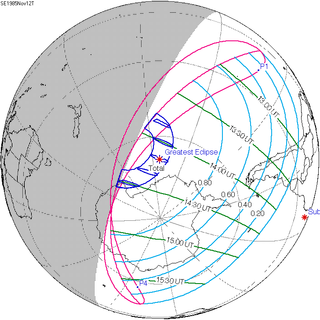| Solar eclipse of November 12, 1985 | |
|---|---|
| Type of eclipse | |
| Nature | Total |
| Gamma | −0.9795 |
| Magnitude | 1.0388 |
| Maximum eclipse | |
| Duration | 119 s (1 min 59 s) |
| Coordinates | 68°36′S 142°36′W / 68.6°S 142.6°W |
| Max. width of band | 690 km (430 mi) |
| Times (UTC) | |
| Greatest eclipse | 14:11:27 |
| References | |
| Saros | 152 (11 of 70) |
| Catalog # (SE5000) | 9477 |
A total solar eclipse occurred at the Moon's descending node of orbit on Tuesday, November 12, 1985,[1] with a magnitude of 1.0388. A solar eclipse occurs when the Moon passes between Earth and the Sun, thereby totally or partly obscuring the image of the Sun for a viewer on Earth. A total solar eclipse occurs when the Moon's apparent diameter is larger than the Sun's, blocking all direct sunlight, turning day into darkness. Totality occurs in a narrow path across Earth's surface, with the partial solar eclipse visible over a surrounding region thousands of kilometres wide. Occurring about 2 hours after perigee (on November 12, 1985, at 12:30 UTC), the Moon's apparent diameter was larger.[2] Perigee did occur during the early portion of the eclipse.
Totality was visible only near Antarctica. A partial eclipse was visible for parts of southern South America and Antarctica.
- ^ "November 12, 1985 Total Solar Eclipse". timeanddate. Retrieved 9 August 2024.
- ^ "Moon Distances for London, United Kingdom, England". timeanddate. Retrieved 9 August 2024.
